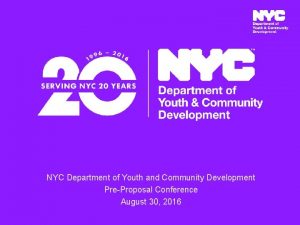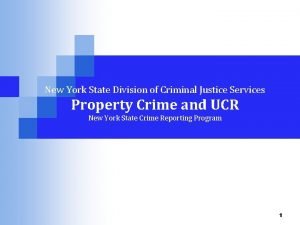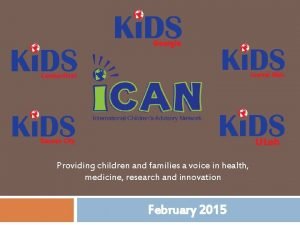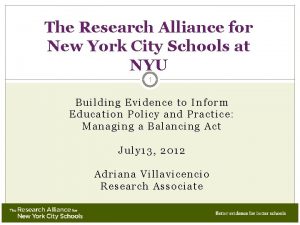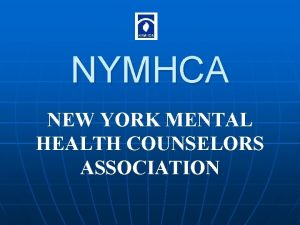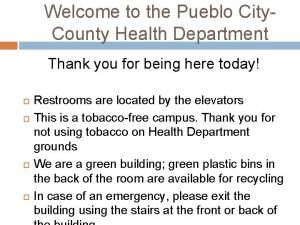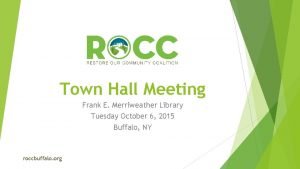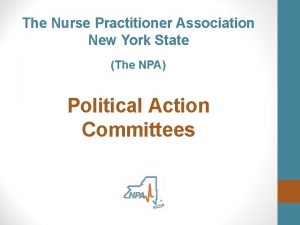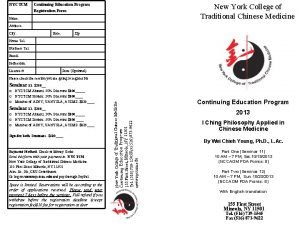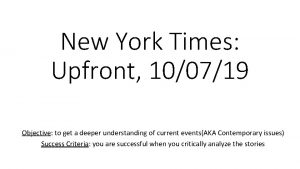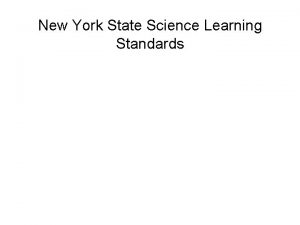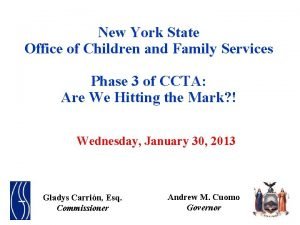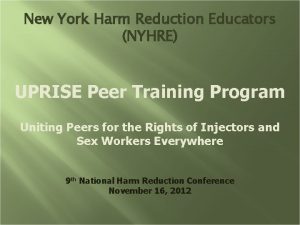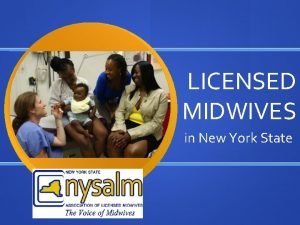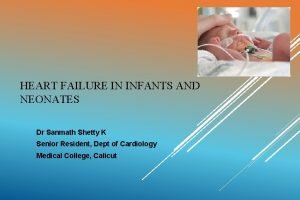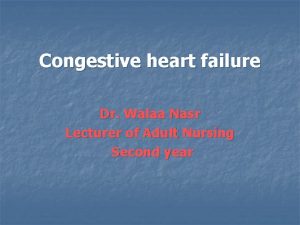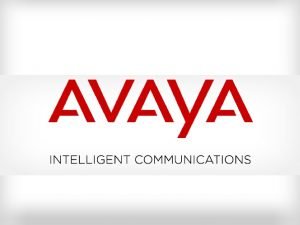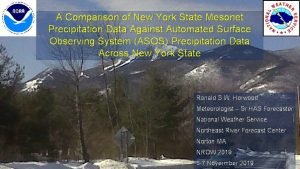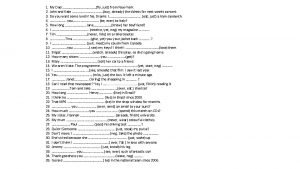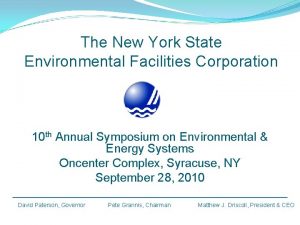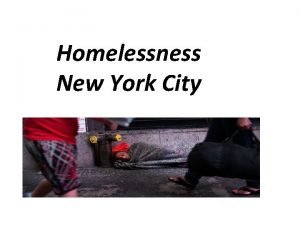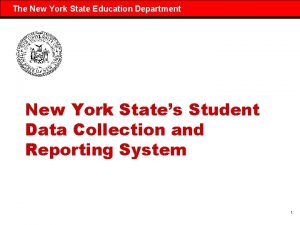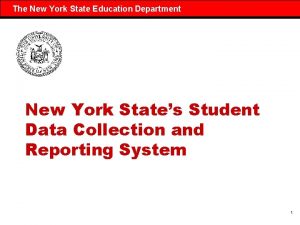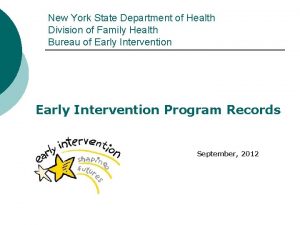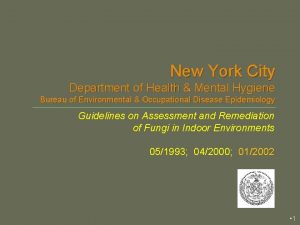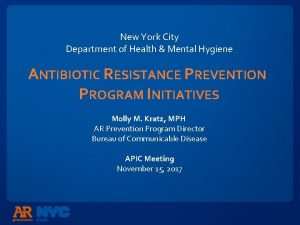New York City Health Department Division of Disease























































- Slides: 55

New York City Health Department Division of Disease Control Overview of Disease Reporting David Lee, MPH, MBA Muriel Silin, MPH Lixuan Wang, MPH

ØReportable Disease Surveillance ØTuberculosis B (TB) Reporting ØImproving Provider Reporting ØElectronic Case Reporting ØQuestions and Feedback

Reportable Disease Surveillance • Disease surveillance is the cornerstone of public health o Provider reports o Electronic laboratory reports (ELR) • Data are used to inform case management activities and public health interventions • In addition, reporting is reinforced by: o State mandates NYS Sanitary Code o City mandates NYC Health Code • Requires reporting of some diseases addition to NYS Sanitary Code

NYC Health Code • Provider reporting requirements in Health Code Article 11 and lab reporting requirements in Article 13 • Routinely reviewed and amended to accommodate: o Evolving diseases and conditions of interest o Advances in reporting and surveillance capabilities • Proposed amendments to the Health Code must be approved by the 11 -member Board of Health • Data collected for public health purposed is not subject to HIPAA

Case reporting: Who? What? • Who needs to report? o Providers o Hospitals • What diseases are reportable? o Specific diseases and conditions (~90) o Outbreaks (in 3 or more persons) of any disease o Unusual manifestations of a disease/condition o Any newly apparent or emerging disease/syndrome

Case reporting: Why? Data are used for surveillance. • Follow disease trends over time • Conduct contact and contact investigations o Case isolation; e. g. TB, SARS o Prophylaxis; e. g. Hep A, meningitis o Contact tracing; e. g. TB, STIs including HIV • Identify and investigate outbreaks • Evaluate prevention and control measures

Case reporting: Why? Can’t we just rely on ELR?

Case reporting: Why? Case reports vs ELR • ELR provide vast majority of reportable disease data in NYC • ELR may be necessary for a definitive diagnosis, but are not always sufficient • Providers often have access to information that labs do not and can provide useful context to the lab reports o o More complete demographic and personal information, including behavioral and occupational risk factors Clinical presentation Treatment information Pregnancy status

Case Reporting: When?

Immediately Reportable

Immediately Reportable Provider Access Line (PAL): 866 -692 -3641 • A 24/7 resource for reporting and medical information • When you call to report, an agent will connect you to the appropriate surveillance number or, in nonurgent situations, give you reporting instructions • When you call for information, we will answer your questions about diagnosis, testing, or other public health issues

Reportable within 24 hours

Reportable within 24 hours Reporting Central & URF Reporting Central: (preferred method) register and log in to NYCMED at nyc. gov/nycmed to access Universal Reporting Form (URF): fax or mail form to Health Department

Special Reporting Requirements • HIV/AIDS • Other Conditions & Events o Poisonings (carbon monoxide, lead, other) o Lead poisoning o Window falls o Drowning o Deaths, births, terminations of pregnancy o Immunizations administered & related adverse events o Blood lead levels o Sterilizations

Resources • Refer to details on NYCDOHMH Reportable Diseases website • Download How to Report Diseases, Events, and Conditions to the New York City Health Department (PDF) • Sign up for the Health Alert Network (HAN)

TB Reporting




Patient reported to health department Assigned a BTBC case manager Chart review Interview patient Identify contacts Interview and test contacts Follow-up for cases and contacts through treatment completion


• TB 244

























Improving Provider Reporting

Number of Reports Diseases Reported through Reporting Central 2016 & 2017 (preliminary) 25 000 21 999 2016 20 000 2017 15 000 10 000 5 000 7 734 7 054 3 944 3 864 723 613 611 562 0 is is ly e) en t s sis s n dia rrhea philis u o o o y o m l l i c l r (a ne nt wo ive acte rcu lam ono Sy s o e h C a b C G alm gna Tu inv pylob atitis S ) pre ep p B Cam n H u -i B gro ( s titi us a c p c co He o t ep Str Diseases Reported r he t O

Improving Provider Reporting Learning from Reporting Central (RC) Users • What functionalities do you want to see in RC? • How do we get paper reporters to use RC instead? • What kind of information and guidance do reporters need? • How else can we improve the reporting experience?

Electronic Case Reporting (ECR) • Automated case reporting from electronic health records The future of surveillance Better data for public health o Less manual work for you! Pilot activities with health departments around the country Including NYC DOHMH! • Tell your IT/Informatics staff if you are interested Email rcorrado@health. nyc. gov Refer to NYCDOHMH ECR Website

Questions? Feedback? • General questions: o Licia Wang lwang 4@health. nyc. gov • TB reporting: o Muriel Silin msilin@health. nyc. gov • Electronic case reporting: Rachel Corrado rcorrado@health. nyc. gov David Lee dlee 8@health. nyc. gov



10 th Amendment- powers not specifically delegated to the federal government by the constitution are reserved to the States.

New York City Health Code Title II, Article 11 Reportable diseases and conditions § 11. 03 Diseases and conditions reportable … the Department may conduct such surveillance, epidemiologic and laboratory investigation activities as it shall deem necessary … and implement public health measures to control the disease or condition and prevent additional morbidity or mortality § 11. 11 -49 Exclusion & isolation powers … A case or carrier of the diseases… shall be excluded until two negative stool samples, taken not less than 24 hours apart … § 11. 23 & 11. 55 Quarantine & detention … the health of others … endangered by a case, contact or carrier, or suspected case, contact or carrier of a contagious disease that … may pose an imminent and significant threat … the Commissioner may order the removal and/or detention of such a person …
 Nyc department of youth and community development
Nyc department of youth and community development Nysdot hdm
Nysdot hdm Nys division of criminal justice services
Nys division of criminal justice services Hunger in new york city poem analysis
Hunger in new york city poem analysis Why is new york called the big apple
Why is new york called the big apple New york city technology forum
New york city technology forum How many colors do you see
How many colors do you see Siting
Siting Event new york city
Event new york city Research alliance for nyc schools
Research alliance for nyc schools Pmi nyc chapter
Pmi nyc chapter New york pennsylvania new jersey delaware
New york pennsylvania new jersey delaware Marquee cinema
Marquee cinema Both new hampshire and new york desire more territory
Both new hampshire and new york desire more territory Neil thisse is a loyalist who fled the colonies
Neil thisse is a loyalist who fled the colonies New york mental health counselors association
New york mental health counselors association Pueblo city county health department
Pueblo city county health department Health standards section
Health standards section Communicable disease and non communicable disease
Communicable disease and non communicable disease Business etiquette in new york
Business etiquette in new york Equal protection clause
Equal protection clause Merriweather library
Merriweather library New york state nurse practitioner association
New york state nurse practitioner association West egg and east egg real life
West egg and east egg real life Famous new york street candy
Famous new york street candy Taoki new york
Taoki new york Outline map of new york
Outline map of new york New york kurosu
New york kurosu New york college of traditional chinese medicine mineola
New york college of traditional chinese medicine mineola The new york times upfront
The new york times upfront Application for tap
Application for tap New york state teacher certification examinations
New york state teacher certification examinations New york state standards science
New york state standards science Ccta new york
Ccta new york Nys math test 2016
Nys math test 2016 Lega new yorka
Lega new yorka New york harm reduction educators
New york harm reduction educators Distretti new york
Distretti new york Harlem renaissance map
Harlem renaissance map Midwives new york
Midwives new york Vielfliegertreff offline
Vielfliegertreff offline Causes of cardiomegaly in child
Causes of cardiomegaly in child The great gatsby geography
The great gatsby geography New york oceanic
New york oceanic Isle island new york
Isle island new york Allgemeine informationen über new york
Allgemeine informationen über new york New york hf classification
New york hf classification Federal district court map new york
Federal district court map new york Gitlow v new york constitutional question
Gitlow v new york constitutional question New york avaya
New york avaya Nerfc
Nerfc 102 graphic
102 graphic My dad (fly just) from new york
My dad (fly just) from new york State vegetable of new york
State vegetable of new york New york kerületei
New york kerületei Gigp-28
Gigp-28
